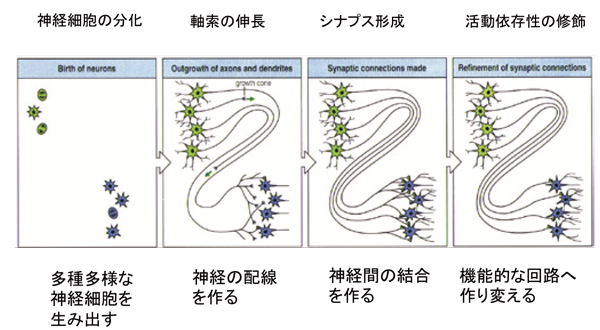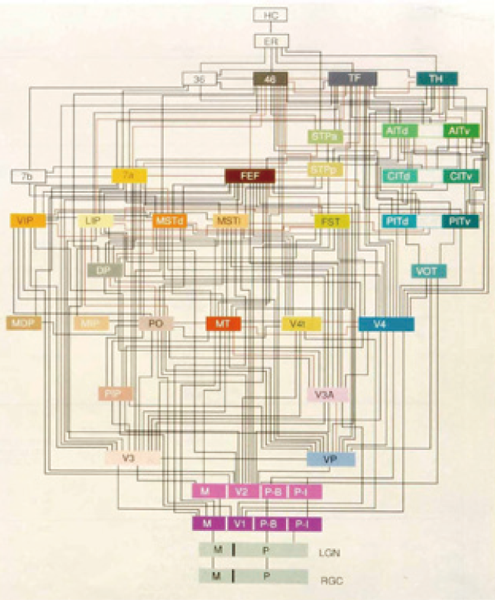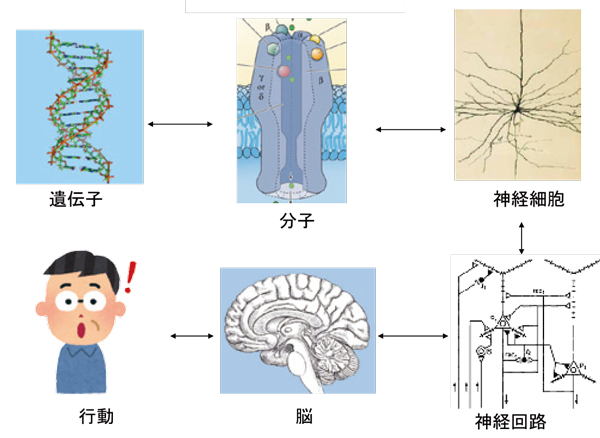キーワード: 神経回路、神経発生、遺伝子、神経活動
http://www.md.tsukuba.ac.jp/duo/molneurobiol/
 脳が働く基盤は脳の中の情報処理の場である神経回路が担っています。この神経回路は、発生期に細胞分化、軸索誘導、シナプス形成などの過程を経て形成されますが(図1)、これらの個別の現象からどのようにして複雑な神経回路網が形成されるか、その分子メカニズムは明らかにされていません。リサーチユニット「統合的神経回路」は、分子レベルから個体レベルまで、統合的なチームを作る事によりミクロからマクロまで包括的な研究を進めています。特に、分子生物学を基本とし、マウスの発生工学的手法を用いつつ、神経系の成り立ちと働きを支える分子の機能を明らかにしようとしています。
脳が働く基盤は脳の中の情報処理の場である神経回路が担っています。この神経回路は、発生期に細胞分化、軸索誘導、シナプス形成などの過程を経て形成されますが(図1)、これらの個別の現象からどのようにして複雑な神経回路網が形成されるか、その分子メカニズムは明らかにされていません。リサーチユニット「統合的神経回路」は、分子レベルから個体レベルまで、統合的なチームを作る事によりミクロからマクロまで包括的な研究を進めています。特に、分子生物学を基本とし、マウスの発生工学的手法を用いつつ、神経系の成り立ちと働きを支える分子の機能を明らかにしようとしています。

図1:神経回路の発達過程
出典:Principles of Development, Lewis Wolpert, Oxford University
Press ISBN 0-19-850263-X より引用、改変
脳のネットワークへのアプローチ方法

図2:視覚情報処理経路
出典:lleman, DJ and Van Essen, DC. (1991) Distributed
hierarchical processing in the primate cerebral cortex.
Cerebral Cortex 1: 1-47. より引用。
脳の働きを理解しようとすると、脳のネットワークを理解しようとしなければなりません。図2にあるComputer 回路のようなしくみを描いただけでは動作原理を解明することはできず、遺伝子からネットワークの全てをつなげて理解しなければなりません(図3)。今までは各々の研究者が別々にその専門分野内で研究を行っていました。この方法では脳の複雑なネットワークの解明には限界があります。そこで、遺伝子を研究している研究者から、人の行動を研究する研究者までがそれぞれの特色を活かし、実験手法を共有した共同研究を行った結果、精神疾患や行動異常に関係する可能性がある遺伝子が新たに見つかってきました。

図3:脳の働き
遺伝子からの行動解明
我々の研究グループのメンバーがもっている日本人の統合失調症の集団と、健常者のデータを比較すると、染色体のどの辺りに原因となる遺伝子変化があるかを探ることができます。そこでマウスで行動異常があることを発見した新たな遺伝子について、健常者と疾患グループで遺伝子の型を比べると、実はその遺伝子が人の双極性障害と関係性がありそうだという事がわかってきました。このように複数の分野の共同により包括的に研究をすすめる事で、より神経回路の動作原理やその異常についての理解につながると考えています。
社会への貢献・実績
● 人の精神神経疾患と関連する遺伝子を同定
● 歩行運動を制御する神経回路を解明。歩行障害治療への応用の可能性も
取材:平成27年7月8日
Integrated study for further understanding of the brain
Unit members : Shiomi, Kensuke Okada, Takuya Shiga, Takashi Koganezawa, Tadachika Keino-Masu, Kazuko Tomoyuki Masuda
Unit name: Neural Circuit
Key words: neural circuit, neural development, gene, neural activity
 Neural circuits process information in the brain and form the basis of brain activities. These neural circuits are developmentally established after a process including cell differentiation, axon guidance, and synapse formation during neural development (Fig. 1). However, the molecular mechanism by which the complicated neural circuit network forms as a result of these individual phenomena has not yet been clarified. This Research Unit “Integrated Neural Circuits” consists of a comprehensive research team, and has performed overall research at levels from molecules to whole organisms (micro-macro levels). For example, we aim to clarify the molecular function of neural circuits using molecular biological methods and formation of the neural system using developmental engineering techniques in mice.
Neural circuits process information in the brain and form the basis of brain activities. These neural circuits are developmentally established after a process including cell differentiation, axon guidance, and synapse formation during neural development (Fig. 1). However, the molecular mechanism by which the complicated neural circuit network forms as a result of these individual phenomena has not yet been clarified. This Research Unit “Integrated Neural Circuits” consists of a comprehensive research team, and has performed overall research at levels from molecules to whole organisms (micro-macro levels). For example, we aim to clarify the molecular function of neural circuits using molecular biological methods and formation of the neural system using developmental engineering techniques in mice.

Fig. 1: Process of neural circuit development
Methods for approaching the brain network

Fig. 2: Visual information processing pathways [lleman, DJ and Van Essen, DC. (1991) Distributed hierarchical processing in the primate cerebral cortex. Cerebral Cortex 1: 1-47.]
To understand brain activities, the brain network should be uncovered. To do so, however, it was not sufficient if we only described the brain network as shown in Fig. 2 similar to computer circuits. For full understanding of brain activities, research on all levels: molecules, genes, cells, cell networks, functions, and human behaviors (Fig. 3), is required. To date, each researcher individually investigated only in each own area, resulting in obtaining fragmental information on the brain network. Therefore, our research unit has collaboratively combined different expertise. As a result, our effort has found new genes that may be associated with psychiatric disorders or behavioral abnormalities.

Fig. 3: Brain activities
Understanding of behavior that genes induce
We are able to search for the chromosomal location of gene alteration causing this disorder by directly comparing genomic data, which a member of our research group built, between on Japanese patients with schizophrenia and on healthy persons.
Searching on our genomic database for a new gene found to be associated with behavioral abnormality in mice, the genotype was compared between the group with the disorder and healthy group. As a result, there was a possibility that this gene is associated with bipolar disorder.
Thus, joint comprehensive research in multiple fields may facilitate the understanding of the operating principles of neural circuits and their abnormalities.
Social contributions and achievements
- Identification of genes associated with neuropsychiatric disorders in humans
- Clarification of the neural circuit controlling walking, showing its potential applicability for treatment of gait disorders
Interviewed on July 8, 2015
